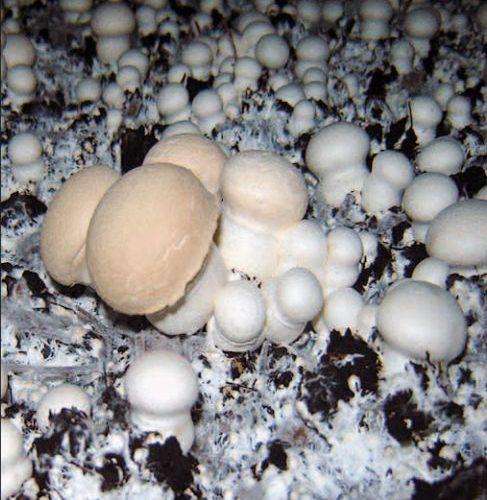The emergence of an unusual Agaricus bisporus mushroom disease first reported in the UK, and later termed as “mushroom virus X” (MVX), exhibits a wide range of symptoms. Findings from laboratories in the UK, the Netherlands and Ireland indicate that symptomatic MVX mushrooms contain a variable compendium of novel 26 (dsRNA) elements, ranging in size between 20.2 kb and 0.64 kb. Four low molecular weight dsRNA bands (sizes 2.0-0.64 kb) are consistently synchronous to mushroom off-color/browning symptoms. This devastating disease first appeared in 1996 on UK farms. MVX is now more widespread and prevalent in a number of European countries (e.g. Netherlands, Ireland). After 2000 this virus affected the crops of 80% of commercial mushroom growers in Great Britain; losses amounted to £50 million.
Symptoms vary and range from the occasional outbreak to severe outbreaks leading to crop losses. Recently a few mushroom farms in Poland reported symptoms of brown-colored mushrooms among the white ones. These observations were very similar to the observations of MVX incidences observed before on Dutch farms. The polis researchers’ work (in Journal of Plant Protection Research) is probably the first information about the possible presence of MVX on Polish mushroom farms.
Two mushroom farms in the Wielkopolska region in Poland reported a strange occurrence of brown mushrooms among the white ones. These farms were located a short distance from each other and used compost from the same supplier. Additionally, they closely cooperated in compost and mushroom logistics. The symptoms appeared at the same time on both farms. No other symptoms were reported as correlating to MVX, like pinning disruption and crop delay or sporophore malformations and loss of yield. The discolorations of mushrooms represented the whole spectrum from slightly brown tinted to strong brown sporophores. It was also not rare to observe that mushrooms picked as white started to lose their color and turned brown during 2–3 days of cool storage.
During the research five consecutive molecular tests were performed to determine the presence or absence of the MVX dsRNAs in the mushroom sporophores. MVX tests were positive only with symptomatic mushrooms grown on the infected farms, while white mushrooms, even if grown on the infected farms were free of MVX.That could suggest that the persistence of the infection was caused by the reinfection of compost at the farm level. The results could suggest that the initial infection happened early in the compost production at the moment of spawning.
The full article available under this link.











